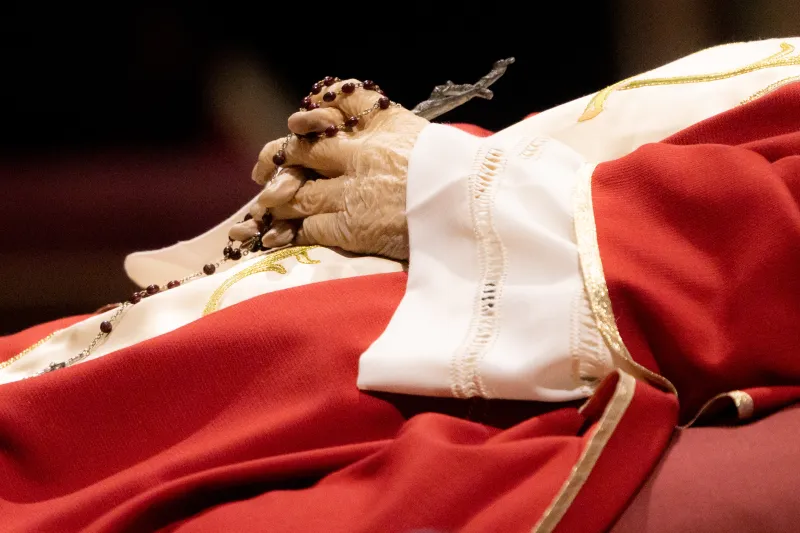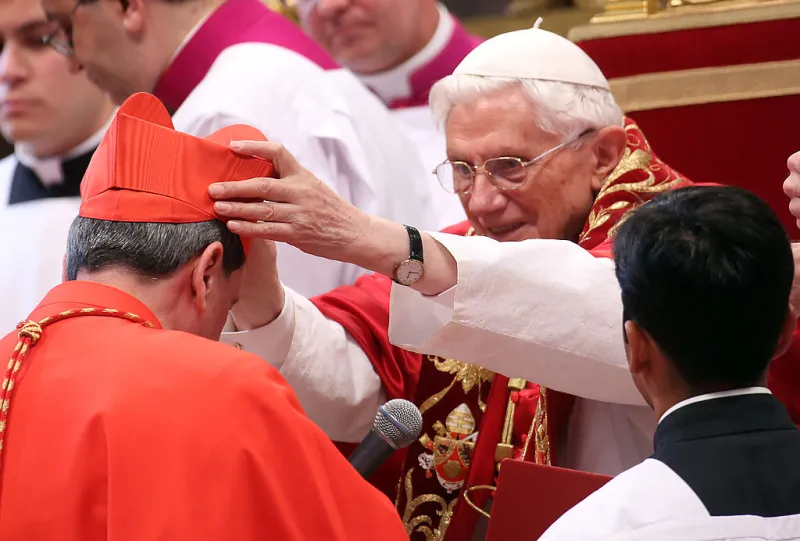 Rosary beads entwined in the hands of the late Pope Emeritus Benedict XVI as his body lies in state on Jan. 3, 2023, in St. Peter’s Basilica. / Daniel Ibañez/CNA
Rosary beads entwined in the hands of the late Pope Emeritus Benedict XVI as his body lies in state on Jan. 3, 2023, in St. Peter’s Basilica. / Daniel Ibañez/CNA
Rome Newsroom, Jan 3, 2023 / 09:07 am (CNA).
The Vatican has released the missal for Pope Emeritus Benedict XVI’s funeral Mass.
Pope Francis will preside over the funeral of Benedict XVI on Thursday, Jan. 5, at 9:30 a.m. (Rome time) in St. Peter’s Square.
Here is a preview of the readings and prayers that will be offered at the funeral of Benedict XVI:
The collect prayer will be prayed in Latin:
Let us pray. O God, who in your wondrous providence chose your servant Benedict to preside over your Church, grant, we pray, that, having served as the Vicar of your Son on earth, he may be welcomed by him into eternal glory. Who lives and reigns with you in the unity of the Holy Spirit, God, forever and ever. Amen.
The readings for Pope Emeritus Benedict XVI’s funeral Mass will be:
In the Prayers of the Faithful, the second prayer will be said in German:
For Pope Emeritus Benedict, who has fallen asleep in the Lord: may the eternal Shepherd receive him into his kingdom of light and peace.
At the end of the Prayers of the Faithful, Pope Francis will pray:
God our Father, lover of life, hear the prayers we raise to you with faith in the Risen Lord for Pope Emeritus Benedict and for the needs of the Church and our world. Grant us a share in fellowship with you in the heavenly Jerusalem, where sorrow and tears will be no more. Through Christ our Lord. Amen.
The Prayer over the Offerings:
Look with favor on the offerings of your Church as she calls on you, O Lord, and by the power of this sacrifice grant that, as you placed your servant Benedict as High Priest over your flock, so you may set him among the number of your chosen Priests in heaven. Through Christ our Lord. Amen.
Prayer at the end of the Eucharistic Prayer III offered in Latin:
Remember your servant Pope Emeritus Benedict, whom you have called from this world to yourself. Grant that he who was united with your Son in a death like his, may also be one with him in his Resurrection, when from the earth he will raise up in the flesh those who have died, and transform our lowly body after the pattern of his own glorious body. To our departed brothers and sisters, too, and to all who were pleasing to you at their passing from this life, give kind admittance to your kingdom. There we hope to enjoy forever the fullness of your glory, when you will wipe away every tear from our eyes. For seeing you, our God, as you are, we shall be like you for all the ages and praise you without end, through Christ our Lord, through whom you bestow on the world all that is good.
The Prayer after Communion will be prayed in Latin:
Let us pray. As we receive sacred sustenance from your charity, O Lord, we pray that your
servant Benedict, who was a faithful steward of your mysteries on earth, may praise your mercy forever in the glory of the Saints. Through Christ our Lord.
After Communion there will be a Final Commendation and Farewell followed by a moment for silent prayer:
Dear brothers and sisters, in celebrating the sacred mysteries we have opened our minds and hearts to joy-filled hope; with confidence we now offer our final farewell to Pope Emeritus Benedict and commend him to God, our merciful and loving Father.
May the God of our fathers, through Jesus Christ, his only Son, in the Holy Spirit, Lord and Giver of Life, deliver Pope Emeritus Benedict from death, that he may sing God’s praises in the heavenly Jerusalem in expectation of the resurrection of his mortal body on the last day.
May the Blessed Virgin Mary, Queen of the Apostles and Salus Populi Romani, intercede before the Eternal Father, that he may reveal the face of Jesus his Son to Pope Emeritus Benedict and console the Church on her pilgrimage through history as she awaits the Lord’s return.
After Pope Francis incenses the mortal remains of Benedict XVI, the pope will pray in Latin:
Gracious Father, we commend to your mercy Pope Emeritus Benedict whom you made Successor of Peter and shepherd of the Church, a fearless preacher of your word and a faithful minister of the divine mysteries.
Welcome him, we pray, into your heavenly dwelling place, to enjoy eternal glory with all your chosen ones. We give you thanks, Lord, for all the blessings that in your goodness you bestowed upon him for the good of your people.
Grant us the comfort of faith and the strength of hope.
To you Father, source of life, through Christ, the conqueror of death, in the life-giving Spirit, be all honor and glory forever and ever.
The choir and the congregation will sing the following Antiphons:
May the angels lead you into paradise; may the martyrs come and welcome you and take you to the holy city, the new and eternal Jerusalem.
May choirs of angels welcome you and with Lazarus, who is poor no longer may you have eternal rest.
As Benedict XVI’s coffin is carried to his place of burial in the crypt of St. Peter’s Basilica, the choir will sing the Magnificat in Latin.
You can view the funeral live on EWTN here.
[…]





